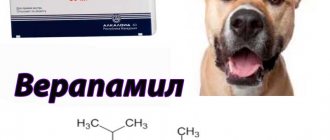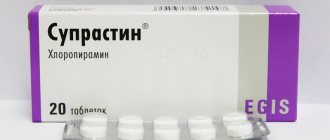- May 13, 2020
- Cardiology
- Ulyana Romanova
"Verapamil" in ampoules is an antiarrhythmic and antianginal drug related to slow calcium channel blockers. For the treatment of what diseases do doctors prescribe it? How should this drug be taken and to whom? Are there any side effects? There are many questions regarding this product; you will find out the answers to the most important ones below.
Compound
Verapamil is produced in ampoules, each of which may contain 5 or 2.5 mg of the active substance. This clear and colorless solution also contains citric acid monohydrate, water for injection, concentrated hydrochloric acid, and sodium hydroxide and chloride.
The product is very cheap. A package of 10 ampoules with a concentration of 2.5 mg can be purchased for 35-40 rubles. It should be noted that the drug can also be found in pharmacies in the form of tablets containing 40 and 80 mg of verapamil hydrochloride.
Verapamil price, where to buy
All forms of the drug can be purchased at any pharmacy. To purchase it you will need a recipe in Latin. The price of Verapamil in 40 mg tablets ranges from 30 to 51 rubles, prolonged-release tablets of 240 mg can be purchased for 153 to 194 rubles, and 10 ampoules of injection solution for 40 to 71 rubles.
- Online pharmacies in RussiaRussia
- Online pharmacies in UkraineUkraine
- Online pharmacies in KazakhstanKazakhstan
LuxPharma* special offer
- Isoptin, Verapamil ampoules 2ml No. 5
RUB 1,100 order
ZdravCity
- Verapamil tab. p.o 80g n50AVVA RUS OJSC
75 rub. order
Pharmacy Dialogue
- Verapamil-LekT (tab.p.pl/vol. 80mg No. 50) Tyumen.khim. factory
53 RUR order
- Verapamil (tablet p/o 80 mg No. 30) Alkaloida
63 RUR order
- Verapamil (tablet p/o 40 mg No. 30) Alkaloida
54 RUR order
- Verapamil retard (tablet p/o 240 mg No. 20) Alkaloida
200 rub. order
show more
Pharmacy24
- Verapamil 0.08 No. 50 tablets PAT NEC "Borshchagivsky chemical-pharmaceutical plant", Kiev, Ukraine
33 UAH. order - Verapamil-Darnitsa 0.04 g N20 tablets PrAT" Pharmaceutical company "Darnitsa", Ukraine
10 UAH.order
- Verapamil-Darnitsa 0.08 g No. 50 tablets PrAT" Pharmaceutical company "Darnitsa", Ukraine
30 UAH order
- Verapamil hydrochloride-Darnitsa 0.25% 2 ml No. 10 emulsion
40 UAH order
PaniPharmacy
- Verapamil ampoule Verapamil liquid solution d/in. 0.25% amp. 2ml No. 10 Ukraine, Darnitsa ChAO
37 UAH order
- Verapamil tablets Verapamil hydrochloride tablets 0.04g No. 20 Ukraine, OZ GNTsLS LLC
6 UAH order
- Verapamil tablets Verapamil hydrochloride tablets 0.04g No. 20 Ukraine, Darnitsa ChAO
11 UAH order
- Verapamil tablets Verapamil hydrochloride film-coated tablets 0.08g No. 50 Ukraine, Borshchagovsky Chemical Plant PJSC
33 UAH order
- Verapamil tablets Verapamil film-coated tablets 0.08g No. 50 Ukraine, Darnitsa ChAO
32 UAH order
show more
Effect on the body
As noted above, Verapamil solution is a drug from the group of “slow” calcium channel blockers. It produces antihypertensive, antianginal and antiarrhythmic effects.
Here's what happens in the human body under the influence of this drug:
- The coronary vessels of the heart dilate.
- The tone of the smooth muscles of the peripheral arteries decreases.
- The automatism of the sinus node is inhibited.
- Coronary blood flow increases.
- The myocardial oxygen demand decreases, as its contractility and heart rate decrease.
- Atrioventricular conduction slows down.
- Peripheral vascular resistance is normalized.
- Metabolism involving cytochrome P450 is suppressed.
Even when the solution is administered in a standard dosage, a decrease in normal pressure is sometimes observed, but it is asymptomatic.
Instructions for use of the drug Isoptin (Verapamil) ampoules 2 ml No. 5
Composition Release form Pharmacological action Pharmacokinetics Indications for use Contraindications Side effects Compatibility with other drugs Application and dosage Overdose Sales conditions Storage conditions Use during pregnancy and breastfeeding Effect on the ability to drive vehicles and operate machinery Special instructions Reviews and recommendations of doctors and patients Under what conditions used for diseases?
Compound
The active substance is verapamil hydrochloride at a dose of 5 mg per 2 ml.
Other ingredients: sodium chloride, water for injection.
Release form
The medication is available in the form of a solution for injection or infusion. The package contains 5 ampoules of 2 ml each.
pharmachologic effect
The active ingredient of the drug is verapamil. Verapamil belongs to a group of medications called calcium channel blockers (or calcium channel blockers) and is a phenylalkylamine derivative. The substance blocks the influx of calcium ions from the extracellular space into cardiac muscle cells and smooth muscle cells of the walls of blood vessels. Acting directly on the heart, verapamil suppresses the cardiac conduction system, increases AV conduction time, and normalizes the frequency of ventricular contractions.
The drug also acts on blood vessels, but this effect is weaker than that of calcium antagonists from the dihydropyridine group. Blocking calcium channels causes a decrease in the tone of the smooth muscles of the vascular walls and dilation of the arteries. In patients with arterial hypertension, verapamil reduces blood pressure and vascular resistance, which facilitates the work of the heart (energy consumption by the heart muscle and oxygen demand are reduced).
The coronary arteries also dilate, which increases oxygen transport to the heart muscle. As a result, the clinical condition of patients with angina improves.
Pharmacokinetics
The substance is quickly absorbed and widely distributed throughout all tissues of the body. Excreted in urine and feces.
Indications for use
The drug is indicated for the treatment of:
- hypertension
- coronary heart disease, including stable and unstable angina, vasoconstrictor angina (Prinzmetall) and angina after myocardial infarction without heart failure (when beta blockers are not indicated)
- cardiac arrhythmias, including paroxysmal supraventricular tachycardia, atrial fibrillation or flutter with rapid ventricular function, excluding WPW or LGL syndrome.
Contraindications
Absolute contraindications are: allergy to the components, cardiogenic shock, excluding shock caused by arrhythmias included in the verapamil indication group, acute complications of myocardial infarction, such as low output syndrome, bradycardia, sinus node insufficiency, tachycardia and bradycardia syndrome, atrial fibrillation and flutter.
Side effects
The most common undesirable manifestations are: drop in blood pressure, irregular heart rhythm, dizziness and headache, nausea, fullness of the stomach. In patients with hypersensitivity to the drug, laryngospasm or bronchospasm associated with urticaria and skin itching occurs.
Compatibility with other drugs
Concomitant use of Isoptin with other drugs that affect the heart (for example, beta blockers, antiarrhythmic agents), as well as with inhaled anesthetics, may lead to increased effects on the heart and circulation. Isoptin may enhance the effect of antihypertensive drugs. Drugs from the group that reduce muscle tension used for anesthesia may enhance their effect under the influence of verapamil.
Application and dosage
Isoptin is administered intravenously. For acute conditions in adults, the initial dose is 5 mg, if necessary after 5-10 minutes. another 5 mg. The maintenance dose for infusion is 5-10 mg/hour. The average daily dose is 100 mg.
Children under 12 months: Initial dose is 0.1 to 0.2 mg/kg body weight (usually 0.75 to 2 mg) over at least 2 minutes, with continuous ECG monitoring, the next dose remains the same.
Children 1-15 years old: the initial dose is 0.1-0.3 mg/kg body weight, not more than 5 mg, for 2 minutes, under constant ECG monitoring, the next dose is the same, not more than 10 mg. The average daily dose is 1.5 mg/kg.
Overdose
In case of drug poisoning, side effects may increase. Calcium is a specific antidote. It is necessary to administer 10-20 ml of a 10% solution of calcium gluconate; if necessary, repeat the same dose or use it intravenously at a rate of, for example, 5 mmol/hour.
Hemodialysis is also effective.
Terms of sale
On prescription.
Storage conditions
The medicine does not require special temperature storage conditions. The shelf life is 3 years.
Use during pregnancy and breastfeeding
The drug should not be prescribed to pregnant women in the first trimester, as well as during lactation.
Impact on the ability to drive vehicles and operate machinery
Depending on the individual reaction, the medication may affect the ability to drive. Therefore, during the treatment period it is necessary to be especially vigilant when driving.
special instructions
It is recommended to avoid drinking grapefruit juice as it may increase the level of the active substance in the blood. Drinking alcohol can lead to a significant decrease in blood pressure.
Reviews and recommendations from doctors and patients
Doctors characterize the medication as an effective and fast-acting antihypertensive and anti-ischemic agent. The medicine is well tolerated, does not affect other medications taken concurrently for other indications, and effectively relieves spasm of the coronary arteries.
SELF-MEDICATION CAN BE DANGEROUS TO YOUR HEALTH. ALWAYS CONSULT WITH YOUR DOCTOR.
For what diseases is it used?
- Arterial hypertension/hypertension
- cardiomyopathy
- angina pectoris
- tachycardia
Pharmacokinetics
By studying the instructions for use of the Verapamil solution, you can find out how it is perceived by the human body.
The substance is 90% bound to plasma proteins. It penetrates the placental and blood-brain barriers, and also passes into breast milk.
Metabolism occurs very quickly and occurs in the liver. As a result of this process, metabolites are formed. The most significant of them is norverapamil. It is he who exhibits pharmacological activity in the body.
Over time, metabolites accumulate in the body (just like verapamil itself). This, in fact, can explain the increased effect during a course of treatment.
The half-life of the active substance is two-phase. The early one is only 4 minutes, and the last one can last from 2 to 5 hours. This compound then leaves the body through the kidneys and along with bile. By the way, it cannot be removed through hemodialysis.
Use during pregnancy and lactation
According to the instructions, Verapamil is contraindicated for use during pregnancy and lactation.
There are no data on the use of the drug in pregnant women.
In animal studies, no direct or indirect toxic effects on the reproductive system were detected. Since the results of animal studies do not reliably predict the response to drug therapy in humans, Verapamil can be used during pregnancy only in cases where the potential benefit to the mother is greater than the estimated risk to the child.
The drug is characterized by penetration through the placental barrier, and it is also found in the blood of the umbilical vein during childbirth.
Verapamil and metabolites are excreted into breast milk. According to the limited available data, the dose of Verapamil that an infant receives via milk is quite low (0.1 to 1% of the amount of Verapamil taken by the mother). Since the possibility of complications for infants cannot be excluded, the drug may be used during breastfeeding only in cases where the potential benefit to the mother is higher than the expected risk to the child.
Indications
According to the instructions, “Verapamil” in ampoules is prescribed to eliminate attacks of the following conditions:
- Supraventricular paroxysmal tachycardia.
- Atrial flutter.
- Atrial extrasystole.
- Paroxysms of flickering.
The injections act quickly and help to urgently cope with the problem. For tablets, the indications are completely different - they are prescribed for arterial hypertension, angina pectoris of various types, heart rhythm disturbances and other conditions that are more stable.
Reviews of Verapamil
Reviews of Verapamil indicate that the drug is an effective treatment for arrhythmias, tachycardia, arterial hypertension, and stable angina pectoris.
During pregnancy, Verapamil is used to treat tachycardia, heart rhythm disturbances, and to reduce uterine tone. Reviews about the effectiveness of the drug during this period are mixed.
Many users note the advantage of Verapamil as its low cost. The most common side effects are constipation, flushing, and bradycardia.
Contraindications
The instructions for use included with the Verapamil solution list all the conditions for which the use of this product is prohibited. The list is as follows:
- Acute myocardial infarction.
- Aortic stenosis.
- Arterial hypotension.
- Cardiogenic shock.
- Morgagni-Adams-Stokes syndrome.
- Ventricular tachycardia.
- Sick sinus syndrome.
- Chronic heart failure II B-III degree.
- Sinoatrial block.
- Digitalis intoxication.
- Atrioventricular block II and III degrees.
- Atrial fibrillation or flutter, combined with Lown-Ganong-Levine or Wolff-Parkinson-White syndrome.
- Treatment with beta-blockers at least 2 hours before Verapamil.
- Porphyria.
- Pregnancy or lactation period.
- Hypersensitivity to the components included in the medication.
- Age up to 18 years.
When is it contraindicated?
While taking the drug, you should regularly examine your cardiovascular and respiratory systems.
Contraindications to taking Verapamil are:
- Recent myocardial infarction, collapse, cardiogenic shock;
- Impaired liver function;
- Ventricular tachycardia, severe heart failure, rare heart rate.
- Aortic stenosis and weak sinus node.
- Age up to 5 years, pregnancy and breastfeeding.
- Drug intolerance.
- Low pressure.
Verapamil should be taken with caution by elderly people, as disturbances in the functioning of the heart are possible.
Relative contraindications
"Verapamil" in ampoules and tablets should be prescribed with caution for the following diseases:
- Pronounced kidney and liver functions.
- First degree atrioventricular block.
- Myocardial infarction accompanied by left ventricular failure.
- Bradycardia.
- The need to be treated with beta-blockers.
- Chronic heart failure I and II A degrees.
- Elderly age.
Before prescribing a drug, the doctor always evaluates the potential risks and possible benefits. And if it is appropriate, he writes out a prescription for Verapamil in ampoules.
Side effects
Since there is a discussion about the instructions for using “Verapamil” in ampoules, then you need to pay attention to the unwanted reactions that may occur if not treated correctly with this drug. These include:
- Allergic reactions: multimorphic exudative erythema, skin itching, hyperemia, rash.
- Gastrointestinal tract: increased activity of alkaline phosphatase and transaminases in the liver.
- Cardiovascular system: collapse, third degree atrioventricular block, worsening or development of heart failure, marked decrease in pressure, bradycardia, tachycardia, arrhythmias, as well as angina pectoris, which can result in myocardial infarction.
- Central nervous system: extrapyramidal disorders, dizziness, depression, headache, drowsiness, fainting, asthenia, anxiety, fatigue, lethargy.
In addition to the above, transient vision loss, peripheral edema, asymptomatic thrombocytopenia, and pulmonary edema are possible.
Side effects
| Body systems affected by Verapamil | Common side effects |
| Digestion and liver | Feeling of nausea and vomiting, difficulty passing stool, relaxation of intestinal sphincters, increased levels of liver enzymes, bleeding from the gums, yellowing of the skin due to increased bilirubin in the blood |
| Heart and blood vessels | Chest pain, arrhythmia of the sinuses and ventricles, pressure drop below the permissible level, myocardial infarction, in severe cases, blockades and cardiac arrest are possible |
| central nervous system | Headache, feeling tired, tension, sleep disturbances, vision problems, hearing problems |
| Genitourinary system | Disruption of the menstrual cycle in women, sexual dysfunction, frequent urination, enlarged mammary glands |
| Allergic reactions | Rash, itching, swelling and bruising, baldness. In severe forms, Quincke's edema and Lyell's and Stevens-Johnson syndromes |
Manifestations of allergies to the drug
Dosage
Now we can discuss the dosage regimen. The product should be injected slowly into a vein over at least two minutes. Be sure to continuously monitor the electrocardiogram, blood pressure, and heart rate. For older people, increase the infusion rate to at least three minutes - this is necessary in order to reduce the risk of developing unwanted effects.
What about the dose? "Verapamil" in ampoules is prescribed individually, but as a rule, the volume of the administered drug varies from 2 to 4 ml (or, if in mg - 5-10 mg).
If there is no effect, the doctor may prescribe a second injection, but only half an hour after the first. The dose is not increased.
When a dropper is indicated, 2 ml of the drug at a concentration of 0.25% is diluted in a 0.9% sodium chloride solution (100-150 ml is enough).
pharmachologic effect
The drug verapamil belongs to type L calcium channel blockers. The substance acts mainly on the cells of the myocardium and blood vessels, due to which the amount of calcium in the blood does not decrease when taking the drug.
The actions of the drug also include:
- Antiarrhythmic (occurs due to blockade of calcium channels, decreased cardiac conductivity, decreased heart rate);
- Antihypertensive (verapamil helps reduce vascular resistance, due to which blood pressure decreases without arrhythmia);
- Antianginal (decreasing vascular tone for their expansion and better blood permeability).
The mechanism of action of Verapamil is to reduce the heart rate (HR), due to which the myocardium needs less oxygen, as a result of which the pressure decreases.
A drug is prescribed for the treatment of angina and tachycardia.
Verapamil is used for high blood pressure and chronic hypertension, when blood pressure rises regularly.
Verampil is quickly eliminated from the body, since the medicine creates many metabolites due to the large interaction with blood proteins. Excretion of the drug occurs mainly through the kidneys within 6 hours, and during treatment with a course - 11 hours.
Overdose
The drug under discussion is a rather serious drug - it is not surprising that abuse or misuse can lead to toxic poisoning.
The following symptoms indicate a serious excess of the dosage of Verapamil in ampoules:
- Sinoatrial block.
- Heart failure.
- Sinus bradycardia, which turns into atrioventricular block or asystole.
- Shock.
- Reduced blood pressure.
In such cases, it is very important to quickly provide assistance to the victim. As a rule, intravenous administration of atropine, isoprenaline, and 10% calcium gluconate solution (10-20 ml) is required.
In some cases, it is necessary to resort to a pacemaker and carry out intravenous infusion of plasma replacement solutions.
If it is necessary to increase blood pressure, the patient is prescribed alpha-agonist agonists. Norepinephrine and isoprenaline alone do not need to be used. Hemodialysis will also not help.
Important instructions
During therapy, it is imperative to monitor the functions of the respiratory and cardiovascular systems. It is important to monitor the amount of electrolytes and glucose in the blood, the amount of urine excreted, and also monitor the volume of circulating blood.
You need to know that the PQ interval may be prolonged if the concentration of the substance in the plasma is above 30 ng/ml.
It is also forbidden to stop treatment suddenly, otherwise there may be consequences and withdrawal syndrome.
And since the drug affects the speed of psychomotor reactions and attentiveness, you need to hold off on things that require concentration.
Interaction with other drugs
“Verapamil” in ampoules is a serious remedy, and this could be seen based on all of the above.
It should be taken into account that the solution is capable of forming various reactions with other chemical compounds. For example:
- Because of it, the concentration in the blood of the following substances increases: valproic acid, digoxin, quinidine, theophylline, muscle relaxants, carbamazepine, cyclosporine, prazosin, theophylline.
- Under the influence of cimetidine, the bioavailability of verapamil increases by 40%, as metabolism in the liver decreases. Therefore, such a combination requires dosage adjustment.
- The simultaneous use of Verapamil with inhalational anesthetics may increase the risk of side effects associated with the cardiovascular system.
- Quinidine and procainamide combined with this drug may prolong the QT interval.
- The effectiveness of "Verapamil" in ampoules is reduced under the influence of calcium preparations, rifampicin, nicotine and barbiturates. These substances also affect its metabolism.
- The hypotensive effect of Verapamil is enhanced by alpha-blockers, prazosin and drugs that normalize blood pressure. And it decreases due to non-steroidal anti-inflammatory drugs, estrogens and sympathomimetics.
- The combination of Verapamil with beta-blockers may increase the negative inotropic effect. And bradycardia may also develop or atrioventricular conduction disturbances may appear.
- "Verapamil" can increase the concentration of cardiac glycosides. Therefore, if such therapy is required, the patient is placed under observation and the dosage is adjusted.
- Flecainide and disopyramide should not be taken within 24 hours after the injection and 48 before it. Otherwise, the negative inotropic effect is cumulative and can be fatal.
- Verapamil should not be combined with lithium drugs, since their neurotoxic effects are then enhanced.
- This drug also increases the activity of peripheral muscle relaxants, which is why it is often necessary to adjust the dosage regimen.
And there are many more such nuances. Therefore, Verapamil is always prescribed to patients only by qualified doctors. The specialist will take into account all the person’s concomitant diseases and the means that he has to take to combat them. Only after analyzing this information will he decide whether this medicine will help him or harm him.
Drug interactions
When Verapamil is used simultaneously with certain medications, the following effects may occur:
- Antiarrhythmic drugs, beta-blockers and inhalational anesthetics: increased cardiotoxic effect (increases the risk of developing atrioventricular block, a sharp decrease in heart rate, the development of heart failure, a sharp decrease in blood pressure);
- Antihypertensive drugs and diuretics: increased hypotensive effect of Verapamil;
- Digoxin: increase in the concentration of digoxin in the blood plasma (to determine the optimal dosage of the drug and prevent intoxication, its level in the blood plasma should be monitored);
- Cimetidine and ranitidine: increase in the concentration of Verapamil in the blood plasma;
- Theophylline, prazosin, cyclosporine: increase in their concentration in blood plasma;
- Muscle relaxants: increased muscle relaxant effect;
- Rifampicin, phenobarbital: decreasing the concentration of Verapamil in the blood plasma and weakening its effect;
- Acetylsalicylic acid: increased likelihood of bleeding;
- Quinidine: an increase in the level of quinidine concentration in the blood plasma, an increased risk of lowering blood pressure, and in hypertrophic cardiomyopathy - the development of severe arterial hypotension;
- Carbamazepine, lithium: increased risk of developing neurotoxic effects.
Reviews
Many doctors consider Verapamil a very important drug in their practice. It copes with its tasks one hundred percent and is also well tolerated by patients. It can even be safely prescribed to people with bronchial asthma, COPD and other serious pathologies.
Plus, along with the improvement in well-being, patients regain their peace of mind. And this is very important when it comes to the cardiovascular system, since there is no need for unnecessary worries for people who have problems with it.
Drug substitutes
There are not very many analogs of “Verapamil” in ampoules, but they exist. Many more alternatives exist in tablet form. Be that as it may, the doctor still prescribes the treatment, but just knowing the names of the analogues will not hurt:
- "Isoptin SR 240."
- "Verapamil-LekT".
- "Veracard".
- "Kaveril."
- "Verapamil-Eskom".
- "Isoptin."
- "Verapamil-ratiopharm".
- "Lekoptin."
- "Vero-Verapamil."
- "Phinoptin".
- "Verogalid EP 240".
The composition of the listed medications is formed by the same substance, which is the main active element of the original drug.
But there are still drugs similar in effect to Verapamil! They have a different composition, but the indications are similar. The full list includes dozens of items, but here are the most famous:
- "Breviblok".
- "Nifecard HL".
- Eliquis.
- "Corinfar.
- "Diltiazem retard."
- "Vero-Amlodipine".
- "Metocard."
- "Felodipin-SZ".
- "Anaprilin."
- "Metoprolol retard-Akrikhin."
- "Listab 75".
- "Plendil."
- "Cordaron".
- "Amlorus".
- "Egithromb."
- "Betalok."
And this is not even a third of drugs similar to Verapamil. In such a pharmaceutical variety, it is easy to get confused and make a mistake - that is why such serious drugs are dispensed with a prescription, which is prescribed by a doctor who knows exactly what will help his patient.
Verapamil's analogs
Level 4 ATC code matches:
Finoptin
Isoptin CP 240
Lekoptin
Synonyms for this drug that have the same active ingredient: Isoptin , Kaveril , Finoptin , Lekoptin .
Verapamil analogues are calcium channel blockers that have a similar effect: Gallopamil , Nifedipine , Nifedipine Retard , Amlodipine , Nicardipine , Riodipine , Nimodipine .








